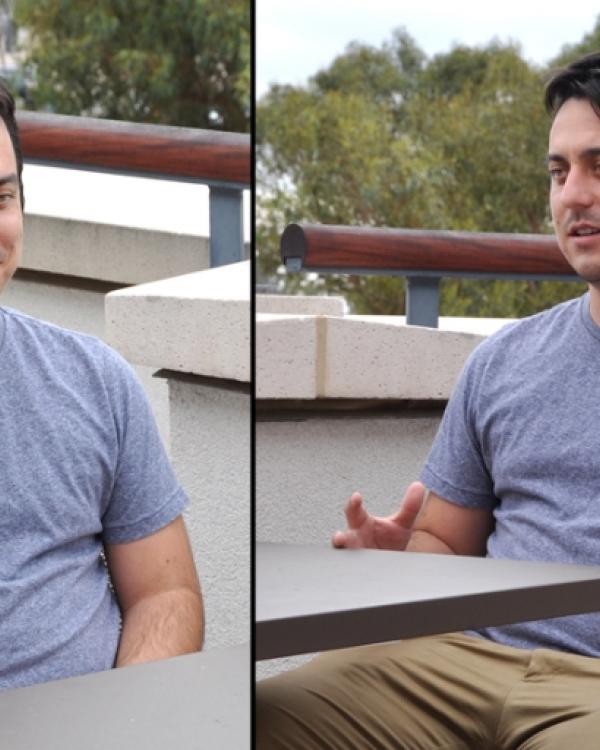
Interested in becoming a special education teacher? Check out our interview with current Teacher Education Program student, Tom Stephens. He shares what experiences inspired him to teach and explains how both low and high tech assistive technologies can help students gain independence and self-determination. #specialed #TEP #ggse
GGSE: What made you decide on the Gevirtz School?
Stephens: I have friends that received their Education Specialist Credential through TEP. I knew it was an option when I was looking at schools. The universities that I looked at in Orange County and Long Beach (UCI, Cal State Fullerton, Cal State Long Beach) either were two years or did not have a special education credential program. I decided I wanted to do special education and get my credential in just one year plus. The TEP at Gevirtz School was the only place that fit what I wanted and was the only program I applied to.
GGSE: So far, what has been a highlight from your fieldwork experience in a classroom?
Stephens: The highlight from working in a classroom is working with students and seeing the progress they make. At my last placement, one first grade student would not sit still at his desk for the first month. He would run out of the classroom onto the playground if any demands were given to him. By the time I left the placement, he was able to sit at his desk for up to an hour and work on a sight word curriculum or write words and letters. I have also had students, before I started TEP, who would not feed themselves with a spoon or fork at the beginning of the year independently eat their lunch with minimal spilling. That is a great accomplishment in independence and self-determination.
GGSE: What issue(s) are you passionate about in education?
Stephens: I am passionate about giving every student the opportunity to learn in the best environment for them. I have always been drawn to being friendly and helping the person who is off to the side. This is probably because I want to be off to the side too. The students that I have the most interest in engaging have gone through multiple aides or teachers because they are difficult to work with. It is an interesting challenge to work with a student that others find difficult.
GGSE: Is there a particular person or experience in your educational background that made you want to teach?
Stephens: Most of my extended family are teachers. Both my maternal grandparents were high school teachers (still alive, retired), a paternal aunt was a teacher and superintendent in Kern County (same as grandparents), a maternal aunt is an elementary school teacher and her husband is getting his special education credential through another program, and at least two of my cousins are elementary school teachers. I have been surrounded by teachers my whole life and I have felt equally at home in a school setting. I think I always knew I was going to be a teacher, but I did not know what I would be teaching.
I started volunteering as a counselor at RAD (Rising Above Disabilities) Camp 10 years ago when I was a sophomore in high school. It began as a way to power through all my community service hours for graduation and has led to me getting my special education credential. I started volunteering and just couldn’t stop. It is difficult to describe the impact it has on people in words. I recommend watching a video or two on their website RAD Camp Videos. RAD Camp is the main experience I had that got me involved in working with people with disabilities.
GGSE: You mentioned you were interested in assistive technology for students. Is there a particular assistive technology that you've observed to be very effective?
Stephens: We are taking an assistive technology course right now. Assistive technology is pretty much anything that assists the student in functional and/or academic task that is not medically implanted in/on their body. The functionality of it depends on the student and how they are taught the assistive technology. In general, I have observed low tech assistive technology to perform better than high tech for fine motor and gross motor skills. Examples include a pencil grip on a pencil or a visual schedule instead of a written schedule. For communication, anything that is portable is best because it should be with the student at all times. I have worked with a man who has a communication device called Tobii that uses his eye gaze to pick the correct letter or word that he wants. It is a difficult device to master, but as he has learned more and more it is opening many doors for him. He is getting really good at taking selfies and cracks jokes at my expense every time I am with him.
GGSE: If you had the opportunity to create or alter existing technologies, what would you create?
Stephens: I am not too creative. I borrow from other people all the time. There is so much out there that I am sure anything I have thought of has already been made, I just have to find it. Right now I am looking for a mid-tech device that will randomly spit out flash cards for a student with a sight word goal. For them to independently work on their goal, I may just have to re-purpose an existing item. However, some alterations that I have made include adding duct tape to the handle of a spoon to increase the grip of the utensil. I have also broken crayons to make them easier to hold in a three finger pincer grip. I refer to Occupational Therapists for assistive technology that has to do with gross and fine motor skills since they are the real experts on assistive technology.